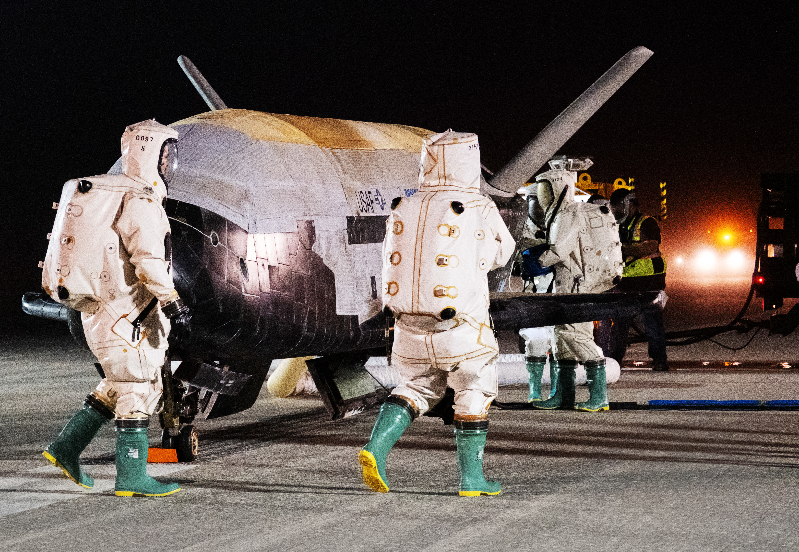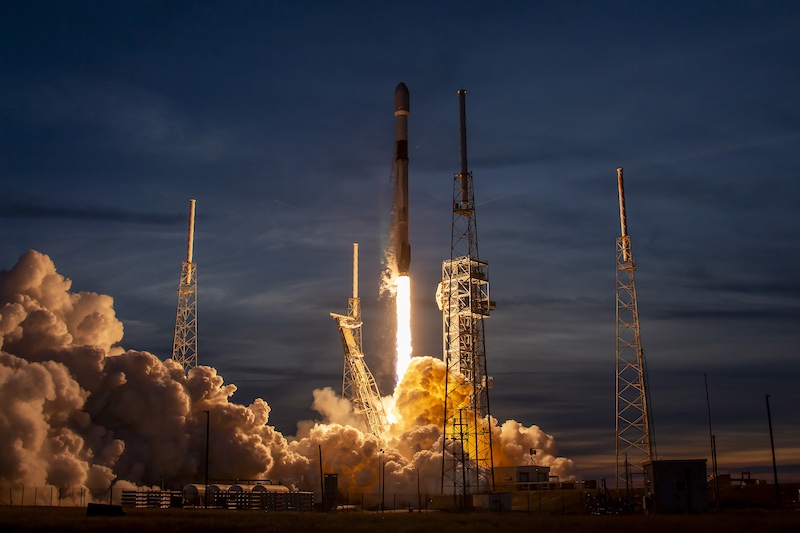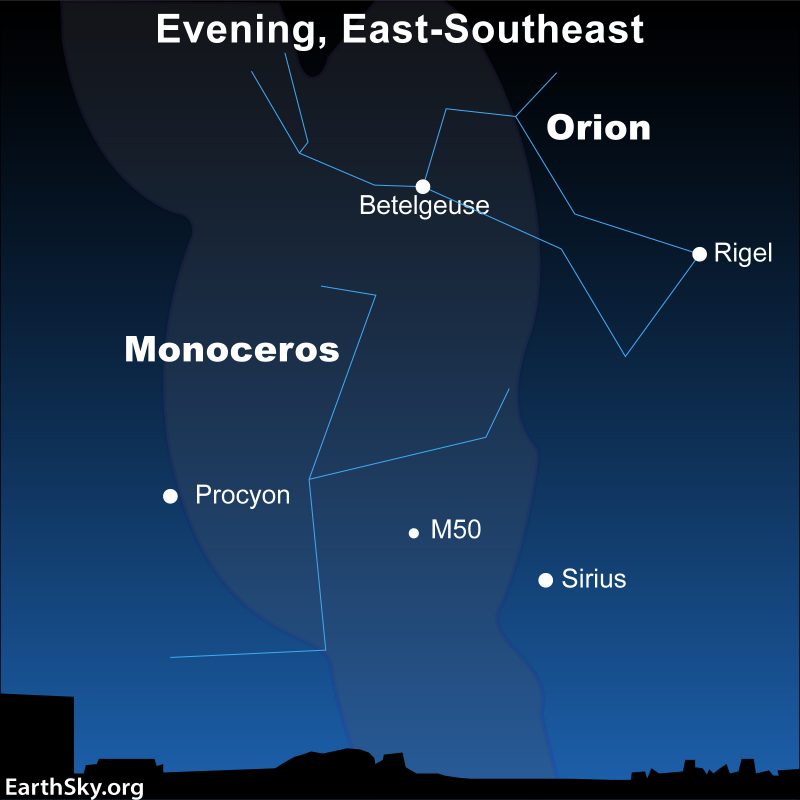
The Space Force secret orbital plane finally lands
After a record 908 days in low-earth orbit, the U.S. Space Force’s X-37B Orbital Test Vehicle-6 (OTV-6) has finally come home. And the uncrewed, reusable craft – looking much like a miniature space shuttle – glided to a touchdown at Kennedy Space Center in Florida at 5:22 a.m. (10:22 UTC) on November 12, 2022.
Naturally as expected for a craft that was probably carrying classified payloads, the Space Force gave few details about what happened aboard the X-37B during its 30-plus months in space. In fact, the chief of Space Operations Gen. Chance Saltzman issued this brief statement when announcing the craft’s safe return:
This mission highlights the Space Force’s focus on collaboration in space exploration and expanding low-cost access to space for our partners, within and outside of the Department of the Air Force (DAF).
Also, there was this statement by Lt. Col. Joseph Fritschen, the DAF Rapid Capabilities Office X-37B Program Director. He said:
The X-37B continues to push the boundaries of experimentation, enabled by an elite government and industry team behind the scenes. The ability to conduct on-orbit experiments and bring them home safely for in-depth analysis on the ground has proven valuable for the Department of the Air Force and scientific community.
Some juicy details
However, the Space Force gave some tantalizing tidbits about a handful of the experiments the X-37B carried. NASA used the opportunity to test the effects of long-duration exposure to space on various materials. As well as there was a similar experiment looking at how low-earth orbit exposure changes plant seeds.
In a more sci-fi vein, the OTV-6 also flew the Naval Research Laboratory’s Photovoltaic Radiofrequency Antenna Module (PRAM) to generate power on orbit and beam it back home:
This experiment successfully harnessed solar rays outside of Earth’s atmosphere and aimed to transmit power to the ground in the form of radio frequency microwave energy.
The European Space Agency recently announced it intends to conduct similar research into space-based solar power generation.
There was also an educational component of the OTV-6 mission, training possible future Space Force officers:
Additionally, the U.S. Air Force Academy’s FalconSat-8, developed in partnership with Air Force Research Laboratory, was successfully deployed in October 2021. FalconSat-8 remains in orbit, providing Academy cadets unique hands-on experience as space operators prior to entering active duty.
What’s the Space Force X-37B really for?
According to the U.S. Air Force – which, before handing off to the Space Force, operated the Boeing-developed OTV program, taking it over from the Defense Advanced Research Projects Agency (DARPA), which had inherited it from NASA – the X-37B is the “newest and most advanced re-entry spacecraft.” This is how it works:
Based on NASA’s X-37 design, the unmanned OTV is designed for vertical launch to low Earth orbit altitudes where it can perform long-duration space technology experimentation and testing. Upon command from the ground, the OTV autonomously re-enters the atmosphere, descends, and lands horizontally on a runway.
While the U.S. military maintains the craft is strictly a platform for experimentation, Russian and Chinese space officials have expressed doubts about the true purpose of the OTV, according to LiveScience.com. Because they fear it has a much more sinister aspect:
Dmitry Rogozin, the former head of Russia’s Roscosmos space agency, claimed in an April interview with the Russian state-owned news channel Russia-24 that the craft could be being used for spying or for carrying weapons of mass destruction. Chinese military expert and commentator Song Zhongping echoed this sentiment, telling the South China Morning Post that the craft’s ability to alter its orbit mid-flight gave it the ability to spy on other satellites or on Earth-based targets, as well as launch attacks from orbit.
Sneaky orbital maneuvers
U.S. officials have played into the impression it’s developing heightened military capability in space using the OTV with statements like this one from former Secretary of the Air Force Heather Wilson, as reported by Military.com:
Wilson called the X-37B “fascinating” because it “can do an orbit that looks like an egg and, when it’s close to the Earth, it’s close enough to the atmosphere to turn where it is.”
“Which means our adversaries don’t know – and that happens on the far side of the Earth from our adversaries – where it’s going to come up next. And we know that that drives them nuts. And I’m really glad about that,” she added.
Wilson was speaking at the Aspen Security Forum in Colorado in 2019.
Astronomer catches Space Force orbital plane working
Because the Space Force doesn’t publicize the X-37B’s comings and goings, and since it can change its orbit on the fly, it has been hard to spot in space. In fact, during its 908-day trip, the X-37B was only photographed once. Surprisingly, an astronomical photographer Ralf Vandebergh captured an image of it in July 2019.
The #OTV5 / #X37B space plane photographed in orbit! Finally an image showing this mini-Space Shuttle which is only a fraction in size of the real Space Shuttle. Nevertheless, the images succeeded beyond expectations and show even a sign of the nose/payload bay/tail or even more. pic.twitter.com/Uy7qBCnoif
— Ralf Vandebergh (@ralfvandebergh) July 3, 2019
A month earlier, Vandebergh caught the X-37B on video. He released only a single frame.
Telescopic recording of X-37B / OTV-5 space plane in orbit on June 29, 2019 that has not yet been released #X37B #OTV5 @SPACEdotcom @DutchSpace @planet4589 @SpaceflightNow @SpaceNews_mil pic.twitter.com/DIYB1167Z7
— Ralf Vandebergh (@ralfvandebergh) October 27, 2019
Bottom line: The U.S. Space Force’s orbital plane returned to Earth on November 12, 2022, after 908 days on orbit.
The post The Space Force orbital plane finally lands first appeared on EarthSky.






0 Commentaires